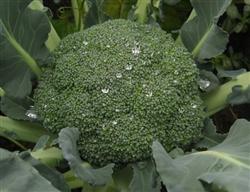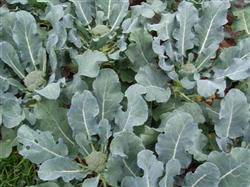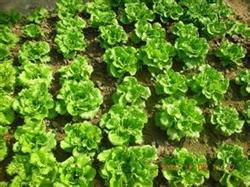Key points of cultivation techniques of open field broccoli in spring

When broccoli is planted in open field in spring, its growth and development is in the season when the temperature is getting higher and the diseases and insect pests are becoming more and more serious. However, in cultivation, as long as we grasp the following five key technologies, we can achieve high yield and high efficiency, and meet the market demand. 1. Sow seeds at the right time. Planting cauliflower in open field in spring can be used with black and green, Tokyo green and other varieties with strong disease resistance, high temperature resistance, compact and neat ball setting. The middle and lower reaches of the Yangtze River were sown in a small arch shed from late March to early April, with about 15 grams per mu of seed and a seeding bed of 7 square meters. After sowing, it was covered with 1 cm thick sifted fine soil and sprinkled with water every morning and evening. When the seedlings have 2-3 leaves, they can be transplanted once, and when they have 5-6 leaves, they can be transplanted. 2. Suitable age colonization. When planting, the seedlings were selected at the age of 25-30 days, with 5-6 true leaves, stout stems, well-developed roots, disease-free and insect-free seedlings, and irrigated with enough water for fixed roots, and then watered the living trees again the next day. The row spacing is 40 × 45 × 50 cm, and about 3000 plants are planted per mu. 3. Scientific training of pipes. About 10 days after planting, 10 kg of urea was applied as seedling fertilizer, 20 kg of compound fertilizer was applied as growth-promoting fertilizer in the vigorous growth period, and 15 kg of urea was applied as bud fertilizer after budding. At the same time, 0, 3% boron fertilizer and 0, 05-0, 1% ammonium cuprate were sprayed twice. Topdressing and watering after the harvest of the main flower bulb promotes the development of the lateral flower head, which requires watering the "three water". The first is to pour enough fixed root water, the second is to pour 1000 kilograms of dilute manure water in 4-5 days to make green seedling water, and the third is to water and promote buds to water in time when the main flower ball grows to 3-6 centimeters. In case of overcast and rainy weather, clear the ditch in time to prevent the performance. At the same time, we should also do a good job of "three grasps". First, we should do a good job of cultivating the soil by ploughing and properly cultivating the soil when watering the seedlings for 3 or 4 days. The second is to grasp the buds, only collect the main bouquet, and erase the lateral buds that appear in the early stage. The third is to grasp the pruning, harvest 4 or 5 lateral branches of the lateral flower bulb, and knock off the rest. 4. Prevent diseases and insects. Cauliflower is mainly caused by three diseases and two insects, namely, black spot, downy mildew, black rot, cabbage worm and diamondback moth. To control black spot, 3% Duoyuqing 600 mg / kg 1000 times solution or 4% agricultural antibiotic 120 water agent 1200 times solution can be used to control black rot. 72% agricultural streptomycin 200 mg / kg plus 10% superphosphate extract or 100 mg / kg neophytomycin can be used for the control of black rot. Tex or Lvtaibao 800 times solution can be used to control downy mildew. The control of Pieris rapae and Plutella xylostella can be controlled by 800-1500 times liquid of "insect blast No. 1" virus B or spraying with borer-killing bacteria 100g 150g and 30kg water. 5. Timely harvest. The harvest time of broccoli is relatively short and must be harvested at the right time. The general harvest standard is that the flower bulb is fully grown, the color is emerald green, the sphere is slightly concave, the flower bud is tight, and the flower ball is solid. Early harvest will affect the yield, so it should be harvested after the dew dries in the morning. With a knife oblique cut flower bulb base with tender flower stem 7 cm, lateral flower bulb with tender flower stem 7 cm 10 cm. Broccoli is not resistant to storage and transportation, it should be packed or sold in time after harvest, and should be shockproof and pressure-proof in the process of transportation.
- Prev

Five keys to the cultivation of broccoli in spring open field
When broccoli is planted in spring open field, its growth and development is in the season when the temperature is getting higher and the diseases and insect pests are becoming more and more serious. As long as we grasp the five key points in cultivation, we can achieve high yield and high efficiency, and meet the requirements of foreign businessmen. First, sowing seeds at the right time. Planting cauliflower in spring open field can be used black and green with strong resistance, high temperature resistance, compact and neat ball setting, east.
- Next

Efficient multiple cropping of cabbage, sweet potato seedlings, eggplant and cauliflower
Lettuce likes cold environment and is neither cold-resistant nor heat-resistant. Therefore, if you plant lettuce well, you should master the following technical links. First, the selection of varieties. When growing lettuce, we should choose varieties with good cold and heat tolerance and good stress resistance, such as ball lettuce, glass lettuce, mosaic lettuce and Caesar. Second, soil.
Related
- Where is it suitable to grow horseradish in China? it is expected to see the middle altitude horseradish in Alishan.
- How to prevent tomato virus disease reasonably? (Control methods included)
- Many people like to plant towel gourd on the balcony. What are the main points of this method and management?
- What crops can chili peppers be mixed with?
- Fertilization techniques and matters needing attention in Tomato
- What are the grafting techniques for peach seedlings in spring?
- Harm and control methods of root swelling disease of Chinese cabbage
- What are the pests of sweet potatoes? How to prevent and cure it?
- Symptoms, causes and Control methods of navel Rot in Tomato
- The cause of "Cucumber rotten bibcock" in Farmers' planting Cucumber and its Control Plan

